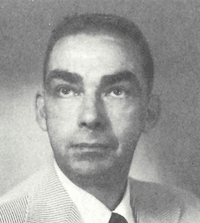Herbert O. House
1929 – 2013
Herbert Otis House was born in Willoughby, Ohio. He received his B.S. degree from Miami University in 1950, and earned his Ph.D. degree at the University of Illinois in 1953 under the supervision of Professor R. C. Fuson. House joined the faculty of the Massachusetts Institute of Technology in 1953 as an Instructor and achieved the rank of Professor in 1964. He moved to the Georgia Institute of Technology in 1971. He retired from Georgia Tech in 1990.
His passion for chemistry was manifest at an early age. By the time House was in the sixth grade, he had constructed a chemical laboratory in the basement of his home! In 1947, he won a Westinghouse Science Talent Award for excellence in chemistry.
He published 177 papers, which have received more than 13,000 citations. At the time of his death, he had an h-index, which is measure of scientific impact based on citations, of 61. House was best known for his pioneering work on the structure and reactivity of enolate anions, which enabled the development of synthetic strategies that became the foundation of modern complex molecule synthesis. During the period 1962 to 1979, he published a remarkable series of 34 papers entitled “The Chemistry of Carbanions” in the Journal of Organic Chemistry. The impact of these papers, which focused on the synthetic aspects of ketone enolate ions, cannot be overstated. In the list of citations of the more than 80,000 papers published in the Journal of Organic Chemistry since its beginning, these papers rank in the top 0.3% in the number of times cited in this journal. He also authored the popular textbook “Modern Synthetic Reactions,” which was used by a generation of chemists.
House was the mentor of 62 Ph.D. students and the supervisor of 44 postdoctoral researchers. His course on synthetic organic chemistry was a model of clarity and logic. As a mentor, the problems he offered were clear-cut and doable. House applauded creativity, but also gave healing suggestions when the experiments didn’t work well. His group meetings engendered wide and insightful discussions. He did not rule, he led.
House received a myriad of honors, including an Alfred P. Sloan Fellowship (1955 – 1959), the ACS Award for Creative Work in Synthetic Organic Chemistry (1975), and the ACS Chemical Health and Safety Award (1983).
His service to the chemical community was extensive, including membership in the ACS Division of Organic Chemistry’s executive board as secretary-treasurer and, from 1979 to 1981, as chairman of the National Academy of Sciences’ Committee on Hazardous Substances in the Laboratory, which led to the publication of the National Research Council’s “Prudent Practices for Handling Hazardous Chemicals in Laboratories.”
House served as a member of the Editorial Board of Organic Reactions from 1965 to 1971 and was a member of the Board of Directors of Organic Reactions from 1971 to 1979. He wrote a chapter, together with A. C. Cope and H. L. Holmes, entitled “The Alkylation of Esters and Nitriles” in Volume 9 (1957) of Organic Reactions.
He is survived by his wife, sister, two children, and six stepchildren.


